.
In accord with their categorial meaning, adverbs are characterised by a combinability with verbs, adjectives and words of adverbial nature (Fig. 97). The functions of adverbs in these combinations consist in expressing different adverbial modifiers.
Adverbs can also refer to whole situations; in this function they are considered under the heading of situation-“determinants”.
Adverbs can also combine with nouns acquiring in such cases a very peculiar adverbial-attributive function, essentially in post-position, but in some cases also in pre-position.
Some adverbs are restricted in their combinability whereas others may modify different words.
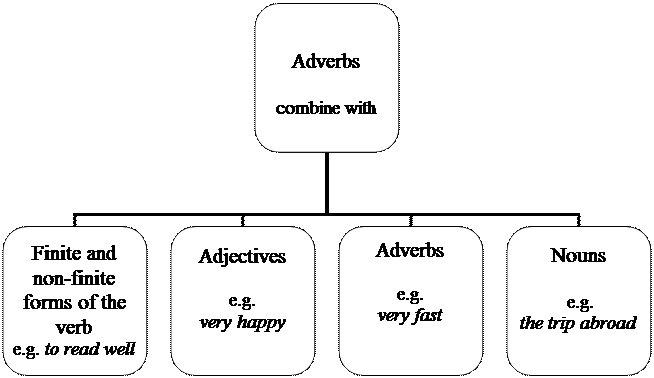
Fig. 97
Adverbs may function as adverbial modifiers of manner, place, time, degree to a finite or non-finite form of the verb. Adverbs may also function as adverbial modifiers to an adjective or another adverb. Usually the modifying adverb is an intensifier.
There are some adverbs which may modify nouns or words of nominal character, functioning as attributes (Fig. 98).

Fig. 98
SYNTAX
WORD-GROUP THEORY
There are a lot of definitions concerning the word-group. The most adequate one seems to be the following: the word-group is a combination of at least two notional words which do not constitute the sentence but are syntactically connected. According to some other scholars (the majority of Western scholars and professors B.Ilyish and V.Burlakova – in Russia), a combination of a notional word with a function word (may be treated as a word-group as well.
General characteristics of the word-group are:
1) As a naming unit it differs from a compound word because the number of constituents in a word-group corresponds to the number of different denotates.
2) Each component of the word-group can undergo grammatical changes without destroying the identity of the whole unit.
3) A word-group is a dependent syntactic unit, it is not a communicative unit and has no intonation of its own.
Word-groups can be classified on the basis of several principles.
1. According to the type of syntagmatic relations w ord-groups can be coordinative, subordinate, predicative (Fig. 99).
Coordinative word-groupings are based on the relations of independence between the constituents.
Coordination may be symmetric and asymmetric. Symmetric coordination is characterized by complete interchangeability of its elements. Asymmetric coordination occurs when the position of elements is fixed.
According to the presence or absence of connectors coordinative word-groupings may be syndetic when the connection is realised with the help of conjunctions and asyndetic when the connection is realised without the help of conjunctions (Fig. 100).
According to the type of conjunctions forms of connection within coordinative word-groupings may be copulative, disjunctive and adversative (Fig. 101).
Fig. 99
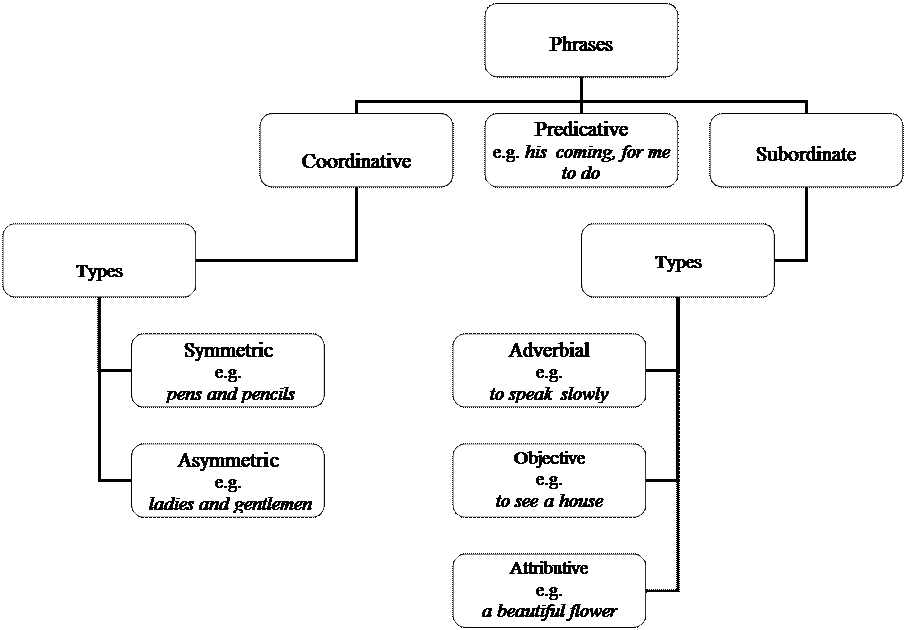

Fig. 100
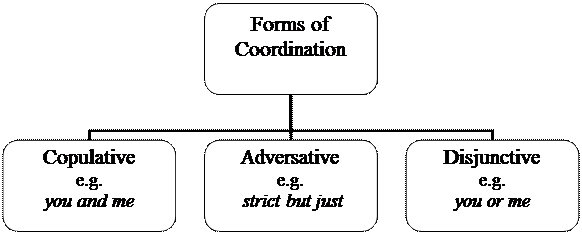
Fig. 101
Subordinate word-groups are based on the relations of dependence between the constituents. This presupposes the existence of a governing element which is called the “head”, “kernel”, “kernel element”, or “headword”and the dependent element which is called the “adjunct”, “adjunct-word”, “expansion”.
Subordination may be of three different kinds – adverbial, objective and attributive (Fig. 99).
Forms of subordination may also be different – agreement, government, adjoinment and enclosure (Fig. 102).
According to the type of the headword subordinate word-groups fall into nominal, verbal, adjectival, adverbial, statival (Fig. 103).
According to the syntactic function of the adjunct subordinate word-groups fall into attributive, object and adverbial (Fig. 104).
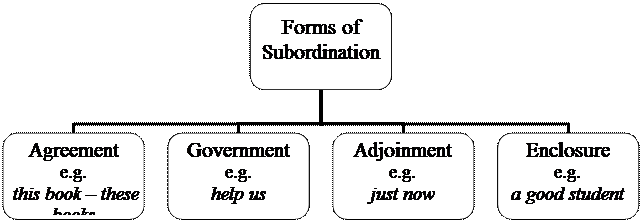
Fig. 102
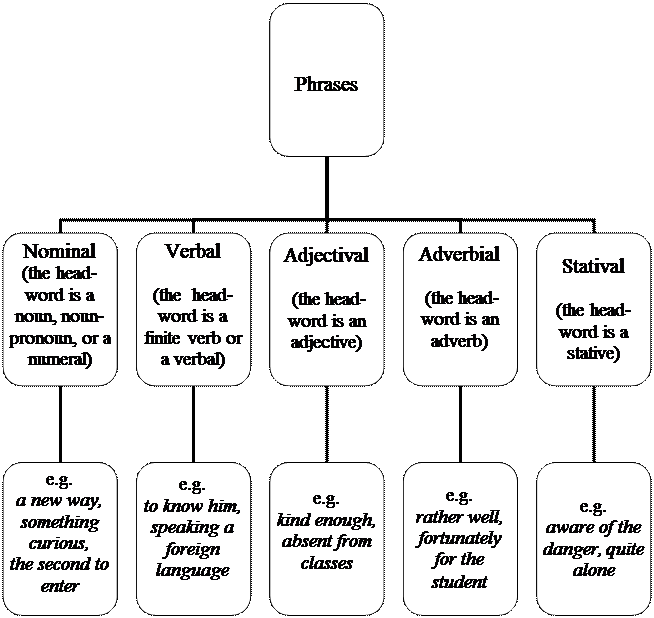
Fig. 103

Fig. 104
According to the position of the adjunct subordinate word-groupings are classed into word-groupings with prepositive adjunct, with mitpositive adjunct, with postpositive adjunct and frame structures (Fig. 105).
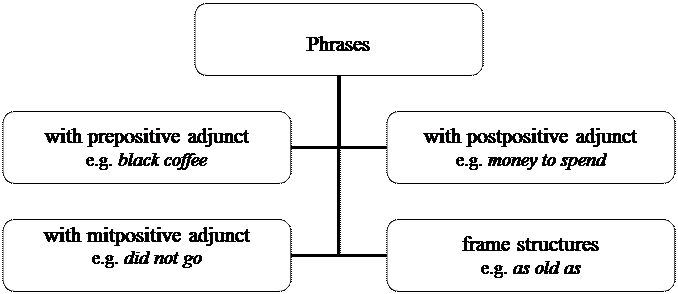
Fig. 105
Predicative word combinations are distinguished on the basis of secondary predication (Fig. 99). Like sentences, predicative word-groups are binary in their structure but actually differ essentially in their organization. The sentence is an independent communicative unit based on primary predication while the predicative word-group is a dependent syntactic unit that makes up a part of the sentence. The predicative word-group consists of a nominal element (noun, pronoun) and a non-finite form of the verb. There are Gerundial, Infinitive and Participial word-groups (complexes) in the English language.
2. According to the number of the constituents word-groups can be binary and multiple (Fig. 106).

Fig. 106
3. According to their structure word-groups are classed into simple (all elements are obligatory), expanded(expanded elements are equal in rank), extended (a word takes a dependent element and this dependent element becomes the head for another word (Fig. 107).

Fig. 107
4. According to their nominative value one should distinguish between syntagmatic groupings of notional words alone, syntagmatic groupings of notional words with functional words, and syntagmatic groupings of functional words alone (Fig. 108).
Fig. 108

Combinations of a notional word with a functional word are equivalent to separate words by their nominative function. These combinations are called “formative”.
Syntagmatic groupings of functional words are essentially analogous to separate functional words. They are used as connectors and specifiers of notional elements of various status. These combinations are called “functional”.
Different combinations of notional words are called “notional” phrases. They have a clearly pronounced self-dependent nominative destination. They denote complex phenomena and their properties in their inter-connections, including dynamic interconnections (semi-predicative combinations).
Groupings of notional words fall into two opposite types by their grammatical and semantic properties.
Groupings of the first type are constituted by words related to one another on an equal rank, so that, for a case of a two-word combination, neither of them serves as a modifier of the other. Depending on this feature, these combinations can be called “equipotent”.
Groupings of the second type are formed by words which are syntactically unequal in the sense that, for a case of a two-word combination, one of them plays the role of a modifier of the other. Due to this feature, combinations of the latter type can be called “dominational”.
Equipotent connection in groupings of notional words is realised either with the help of conjunctions (syndetically), or without the help of conjunctions (asyndetically). If the constituents of the combinations form logically consecutive connections they are classed as coordinative.
There exist equipotent connections of a non-consecutive type, by which a sequential element, although equal to the foregoing element by its formal introduction is unequal to it as to the character of nomination. The latter type of equipotent connections is classed as “cumulative”. Cumulative connection in writing is usually signalled by some intermediary punctuation stop, such as a comma or a hyphen.
Dominational connection is effected in such a way that one of the constituents of the combination is principal (dominating) and the other is subordinate (dominated).
The two basic types of dominational connection are bilateral (reciprocal, two-way) domination and monolateral (one-way) domination.
Bilateral domination is realised in predicative connection of words, while monolateral domination is realised in completive connection of words.
The predicative connection of words, uniting the subject and the predicate, builds up the basis of the sentence.
The completive, one-way connection of words (monolateral domination) is considered as subordinative on ground that the outer syntactic status of the whole combination is determined by the head-word.
All the completive connections fall into two main divisions: objective connections and qualifying connections (Fig. 109).
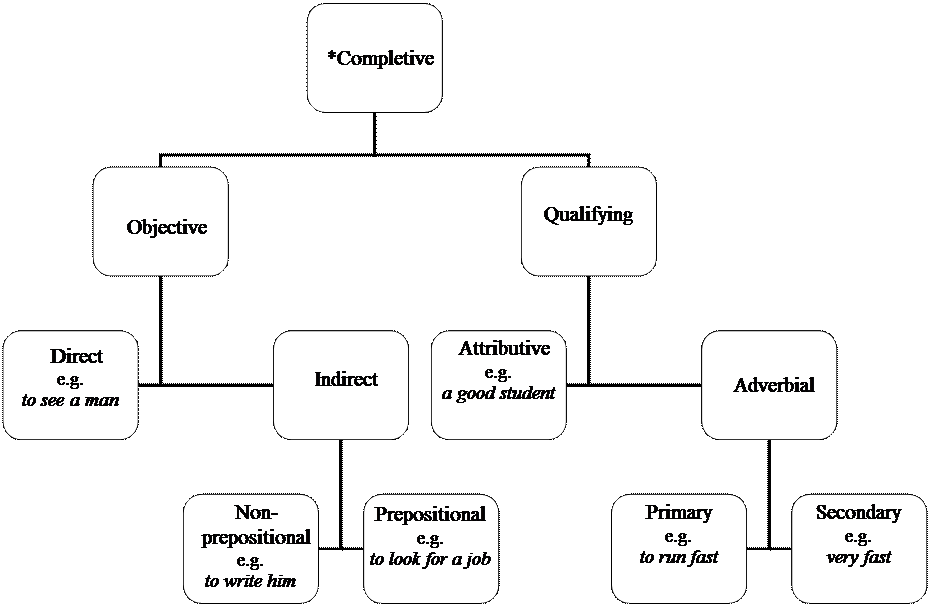
Fig. 109
Objective connections reflect the relation of the object to the process. By their form these connections are subdivided into non-prepositional (word-order, the objective form of the adjunct substantive) and prepositional, while from the semantico-syntactic point of view they are classed as direct (the immediate transition of the action to the object) and indirect or oblique (the indirect relation of the object to the process).
Qualifying completive connections are divided into attributive and adverbial. Both are expressed in English by word-order and prepositions.
Attributive connection unites a substance with its attribute expressed by an adjective or a noun.
Adverbial connection is subdivided into primary and secondary. The primary adverbial connection is established between the verb and its adverbial modifiers of various standings. The secondary adverbial connection is established between the non-verbal kernel expressing a quality and its adverbial modifiers of various standings
SENTENCE: GENERAL
The sentence is the main object of syntax as part of the grammatical theory.
The sentence is the central syntactic construction used as the minimal communicative unit that has its primary predication, actualises a definite structural scheme and possesses definite intonation characteristics. The most essential features of the sentence as a linguistic unit are a) its structural characteristics – subject-predicate relations (primary predication), and b) its semanticcharacteristics – it refers to some fact in the objective reality.
The sentence is characterised by its specific category of predication which establishes the relation of the named phenomena to actual life. The general semantic category of modality is also defined by linguists as exposing the connection between the named objects and surrounding reality. But modality is not specifically confined to the sentence. This is a broader category revealed both in the grammatical elements of language and its lexical, purely nominative elements.
The centre of predication in a sentence of verbal type (which is the predominant type of sentence-structure in English) is a finite verb. The finite verb expresses essential predicative meanings by its categorial forms, first of all, the categories of tense and mood.
The sentence is intonationally delimited. Intonation separates one sentence from another in the continual flow of uttered segments and, together with various segmental means of expression, participates in rendering essential communicative-predicative meanings (such as, for instance, the syntactic meaning of interrogation in distinction to the meaning of declaration). The role of intonation is especially important for sentences which have more than one predicative centre, in particular more than one finite verb. Special intonation contours, including pauses, represent the given speech sequence in the first case as one compound sentence, in the second case as two different sentences.






